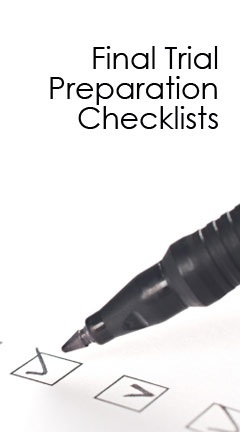Archival Notice
This is an archive page that is no longer being updated. It may contain outdated information and links may no longer function as originally intended.
Home | Glossary | Resources | Help | Course Map
Create trial preparation checklists with or without assistance from counsel.
A. Preparing With Assistance From Counsel.
- Focus on a trial theme.
- Decide the order of proof (see Useful Steps for Self-Preparation Appendix, Step 1).
- Practice and refine testimony.
- Re-examine tangible evidence.
- Obtain preapproval of demonstrative materials and visual aids.
- Stage the testimony:
- Confirm time and place for testimony.
- Establish order of presentation.
- Determine movements around the hearing room.
- Determine what tools, devices or equipment will be needed.
- Review the discovery.
- Anticipate any evidence problems.
- Translate any technical terms.
- Structure and organize the testimony.
- Consider the audience and venue.
- Meet with the other experts and the attorney(s).
- Consider practical matters.
- Use appropriate dress and demeanor.
- Transport all needed materials, visual aids and equipment to court.
- Ensure in advance that all equipment works properly.
- Anticipate the opposition's plans and questions.
- Read and review testimony tips (See General Testifying Tips).
- Remember the expert's role:
- Relax.
- Be Open.
- Listen carefully and lean forward.
- Keep your Eyes on the questioner and the intended audience (judge or jury).
B. Preparing Without Assistance From Counsel.
- Determine the main task.
- Determine how the materials will be presented.
- Tell the evidence story succinctly.
- Revisit the evidence.
- Practice and refine all demonstrations.
- Review all depositions and interrogatories.
- Is the expert's evidence admissible?
- Helpful.
- Reliable.
- Relevant.
- Trustworthy.
- Nonrepetitive.
- Well-founded.
- Accurate.
- First-hand data.
- Ensure that all technical terms are translated.
- Ensure that the visual aids are ready.
- Consider the forum and the attorneys.
- Meet with other experts if possible.
- Suggest key questions for the attorney.
- Deal with scheduling problems.
- Dress to look professional.
- Transport materials to the hearing.
- Study potential cross-examination from the opposing side.
- Find out when and where to be, and be there.
Additional Online Courses
- What Every First Responding Officer Should Know About DNA Evidence
- Collecting DNA Evidence at Property Crime Scenes
- DNA – A Prosecutor’s Practice Notebook
- Crime Scene and DNA Basics
- Laboratory Safety Programs
- DNA Amplification
- Population Genetics and Statistics
- Non-STR DNA Markers: SNPs, Y-STRs, LCN and mtDNA
- Firearms Examiner Training
- Forensic DNA Education for Law Enforcement Decisionmakers
- What Every Investigator and Evidence Technician Should Know About DNA Evidence
- Principles of Forensic DNA for Officers of the Court
- Law 101: Legal Guide for the Forensic Expert
- Laboratory Orientation and Testing of Body Fluids and Tissues
- DNA Extraction and Quantitation
- STR Data Analysis and Interpretation
- Communication Skills, Report Writing, and Courtroom Testimony
- Español for Law Enforcement
- Amplified DNA Product Separation for Forensic Analysts


